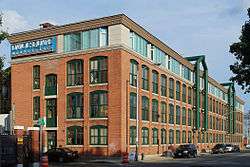Davol Rubber Company
The Davol Rubber Company is a historic industrial site at Davol Square, at Point and Eddy Streets in Providence, Rhode Island.
Davol Rubber Company | |
 Davol Square | |
  | |
| Location | Providence, Rhode Island |
|---|---|
| Coordinates | 41°49′2″N 71°24′25″W |
| Built | 1880 |
| NRHP reference No. | 80000093 [1] |
| Added to NRHP | June 27, 1980 |
The building was constructed in 1880 and added to the National Register of Historic Places in 1980. It is located adjacent to the historic South Street Landing, which was renovated in 2017. The Providence Jewelry Manufacturing Historic District is also nearby.
History

The Perkins Manufacturing Company was founded in Providence by Emery Perkins and Joseph Davol in 1874, after two years of experiments and inventions by Joseph Davol.[2] It produced rubber medical and surgical devices, such as hot water bottles and catheters.[3] In 1878, Davol took control of the company and renamed it the Davol Manufacturing Company; in 1884 it became the Davol Rubber Company.[2]
In 1934, the company began the manufacture of the Foley catheter.[4] In 1971, the Davol Rubber Company opened a new facility in nearby Cranston, Rhode Island. The company was acquired by C.R. Bard, Inc. of New Jersey in 1980. The Davol Company, as it is currently known, is now located in Warwick, Rhode Island.[5]
Recent projects
Since Davol Rubber left, the building has had a series of tenants. The short-lived Davol Square Marketplace mall occupied the building complex in the 1980s. Later, it housed a mini-convention center for the costume jewelry industry for a short while. Various projects associated with Brown University have rented space in the building for many years, and the university recently announced plans to buy several buildings in the area.[6]
References
- "National Register Information System". National Register of Historic Places. National Park Service. January 23, 2007.
- "Rhode Island Historical Preservation & Heritage Commission Statewide Historical Preservation Reports". Little Rhody's list of Rhode Island information. Retrieved 1 February 2016.
- "Davol history". Archived from the original on 2008-06-27. Retrieved 2008-08-14.
- "CR Bard Website history". Archived from the original on 2008-05-30. Retrieved 2008-08-14.
- Providence Journal Article, July 25, 2006
- 06-043 (Jewelry District Properties)
External Links
- While You're Waiting...Things to do Before the Baby Comes booklet from the Rhode Island State Archives